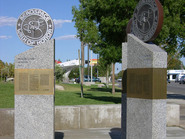Johnson Space Center Tourist attraction in Houston, United States
On February 8, 1965, Armstrong and See were announced as the backup crew for Gemini 5, with Armstrong as its commander, supporting the prime crew of Gordon Cooper and Pete Conrad. The purpose of the mission was to practice space rendezvous and to develop procedures and equipment for a long-duration flight of seven days. These would be required for a mission to the Moon. With two other flights (Gemini 3 and Gemini 4) in preparation, there were six crews competing for simulator time, resulting in Gemini 5 being postponed. The mission lifted off on August 21. Armstrong and See watched the launch at Cape Kennedy, and then flew to the Manned Spacecraft Center in Houston. The mission was generally successful, despite a problem with the fuel cells that prohibited a rendezvous. They practiced a "phantom rendezvous", carrying out the maneuver without a target.
Source: Wikipedia



